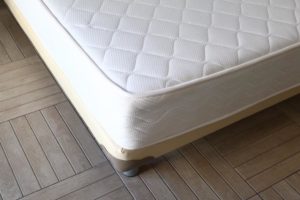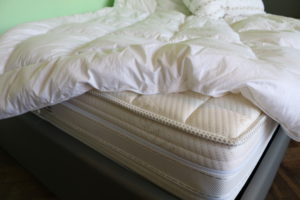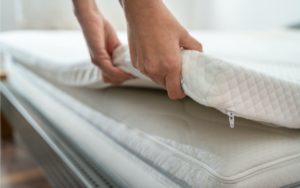Signs and Effects of a Bad Mattress
Sleep impacts nearly every aspect of your health and wellbeing. Without restful sleep, your body doesn’t have the resources it needs to function properly. One of the simplest solutions for a good night’s sleep is a comfortable mattress. If your mattress is failing to deliver the comfort and support you need, it may be time for a new one.
Many factors influence the durability and lifespan of a mattress. While all mattresses eventually degrade, a mattress constructed with high-quality materials tends to hold out for longer before developing sagging or permanent body indentations. Once these problems occur, your mattress is no longer able to provide adequate spinal support and pressure relief.
Recognizing the early signs of a bad mattress can help you avoid some of the uncomfortable side effects of sleeping on one.
Signs of a Bad Mattress
The warning signs of a bad mattress aren’t always obvious, but if you’re experiencing any of the following, it might be an indication that your mattress isn’t performing as it should.
Aches and Pains: Waking up with aches and pains may be due to the comfort layers in your mattress breaking down, causing pressure points when you sink onto the firmer support core.
Poor Sleep: Tossing and turning on an uncomfortable mattress may result in poor sleep quality, even if you’re not consciously aware of it. If you no longer wake up feeling refreshed, your mattress may be at the end of its life. Other signs that your mattress is affecting your sleep include waking up multiple times a night or taking longer than usual to fall asleep.
Sagging: Almost all mattresses start to sag over time as a result of supporting the weight of your body night after night. A sagging mattress can lead to uneven spinal support, which may cause pressure to build up in your back and neck as you sleep. Seeing permanent body indentations in the mattress is a clear sign that it needs replacing.
Poor Support: The layers of the mattress are meant to work together to support the shape of your spine. The comfort layers should conform to encourage proper spinal alignment without excessive sinking. Similarly, the support core should provide a stable base to support the heavier parts of the body and keep the spine on an even plane. If you are waking up stiff and sore, it may be due to an unsupportive mattress.
Excessive Heat: A mattress’ temperature regulation abilities mostly depend on the materials used in its construction. Mattresses with coil support cores tend to sleep cooler, while foam mattresses trap more heat due to their solid construction. While many manufacturers use gel infusions or phase change material to reduce the heat retention of a foam mattress, these materials can wear out over time and lead to an uncomfortably warm sleep surface. The comfort layers may also become softer, allowing you to sink further into your mattress and leaving less room for airflow around the body.
Allergen Buildup: Allergen buildup is common in worn mattresses, which have had plenty of time to collect pet dander, mildew, mold, and other allergens. If you struggle with allergies at home, your worn mattress may be one of the culprits. You can protect against mold and mildew by using a mattress foundation that leaves room for airflow beneath the mattress, and reduce allergen buildup by using a machine-washable mattress protector.
Dust Mites: Mattresses accumulate dead skin cells that attract dust mites. For people with allergies, dust mites can cause sneezing, watery eyes, sinus pressure, and runny noses. Innerspring mattresses are more likely to harbor dust mites, whereas latex and foam mattresses have less open spaces for them to live. Periodically vacuuming your mattress or using a mattress protector may help keep out dust mites.
Mattress Age: While some mattresses last longer than others, sooner or later all mattresses start to lose their pressure-relieving and supportive capabilities. Improper care, added weight, and failure to use a proper foundation can all shorten a mattress’ lifespan.
“Mattress Envy”: When your mattress fails to deliver balanced support and comfort, you may find yourself developing mattress envy for other beds. If you feel more refreshed after sleeping on a hotel bed than you do at home, your mattress likely isn’t serving its purpose.

Can a Bad Mattress Cause Health Problems?
A bad mattress can cause discomfort, making it more difficult to fall asleep and potentially leading to multiple nighttime awakenings. In turn, poor sleep quality has effects on your physical and mental health.
The restorative benefits of quality sleep are unparalleled. During sleep, your body is hard at work repairing tissue damage, removing toxins, and building new mental pathways. Restorative sleep promotes healthy emotional regulation and helps your brain efficiently process information. Going short on sleep not only leads to next-day fatigue and grumpiness, but may eventually contribute to a wide range of health problems.
Studies have connected poor sleep to memory and concentration problems, weakened immune system functioning, obesity, high blood pressure, diabetes, and cardiovascular disease. A mattress that fails to provide adequate support or pressure relief may also contribute to aches and pains the next day. This may be especially important for individuals who live with chronic pain.
Investing in a quality mattress is one of the most straightforward ways to promote restful sleep and improve your overall health.
How Long Do Mattresses Last?
On average, most mattresses last about 7 to 10 years. However, many factors can influence the durability and lifespan of a mattress.
The quality and materials of a mattress significantly impact how it performs. Mattresses made with denser foams, natural latex, thicker coils, or higher coil counts are better equipped to accommodate the weight of the sleeper and rebound back to their original shape time after time. By contrast, lower-quality foams and coils may break down sooner.
Certain types of mattresses may last longer than others. Natural latex is durable and tends to hold up the longest. Low-quality innerspring mattresses often start sagging after a few years, and foam mattresses may soften and develop permanent body indentations. Hybrid mattress manufacturers often attempt to circumvent these problems by using higher-quality comfort layers and supporting them with sturdier coils.
How much pressure the mattress supports also influences its lifespan. Single sleepers and individuals who weigh less than 130 pounds exert less pressure on the mattress, and may find their mattresses last longer. Likewise, a mattress that is used nightly sustains more pressure than a guest room bed. While a low-density polyfoam model may provide a perfectly comfortable option for a mattress intended for occasional use, your everyday bed should be made with sturdier materials that can hold up to consistent wear.
Following the manufacturer’s guidelines and caring properly for your mattress may help extend its lifespan. Most manufacturers recommend rotating your mattress regularly to delay the appearance of permanent body impressions or sagging where the sleeper usually lies. Protective covers can also help preserve your mattress.
Since mattresses wear out gradually, many sleepers become accustomed to the feel of an old mattress and may not realize it needs replacing. If you’re experiencing any warning signs or if your mattress is more than 6 to 8 years old, you may want to consider replacing your mattress in order to ensure proper spinal alignment and restorative sleep.
Can You Fix a Bad Mattress?
A new mattress is a major expense, but it’s hard to put a price on good sleep quality. If your budget allows for a new mattress, it may be worth the investment. A high-quality mattress is less likely to degrade quickly, which can save you money in the long term.
However, buying a new mattress isn’t always feasible. If you’re unable to invest in a new mattress, there are steps you can take to improve the performance of your current one.
When you sleep in the same spot every night, your body eventually leaves a lasting impression. Rotating the mattress head-to-foot may give you access to a more responsive sleep surface in a different area of the bed. It’s good practice to rotate the mattress every 3 to 6 months to promote even wear, even before you start to notice sagging. Traditional innerspring mattresses can also be flipped, though most modern mattresses are designed to be used right-side up.
A mattress that is not suited to your body type and sleeping style can be just as detrimental as a poor-quality mattress. If your mattress is too firm or too soft, you may be able to improve the feel by using a mattress topper. Mattress toppers are typically 1 to 3 inches thick, and they may be made with memory foam, polyfoam, latex, wool, or other cushioning materials. They are designed to adjust the firmness of the sleep surface, but they cannot fix a sagging mattress.
Changing your pillow or adding extra pillows may help compensate for an uncomfortable mattress, at least until you have the chance to purchase a new mattress. You should also check the bed frame to ensure the problems are not coming from the foundation.
Despite your best efforts, your mattress will eventually reach the end of its lifespan. If possible, invest in a new mattress constructed with high-quality materials. You should also choose a mattress that properly supports your unique body type and sleep position.

Still have questions? Ask our community!
Join our Sleep Care Community — a trusted hub of sleep health professionals, product specialists, and people just like you. Whether you need expert sleep advice for your insomnia or you’re searching for the perfect mattress, we’ve got you covered. Get personalized guidance from the experts who know sleep best.




















































